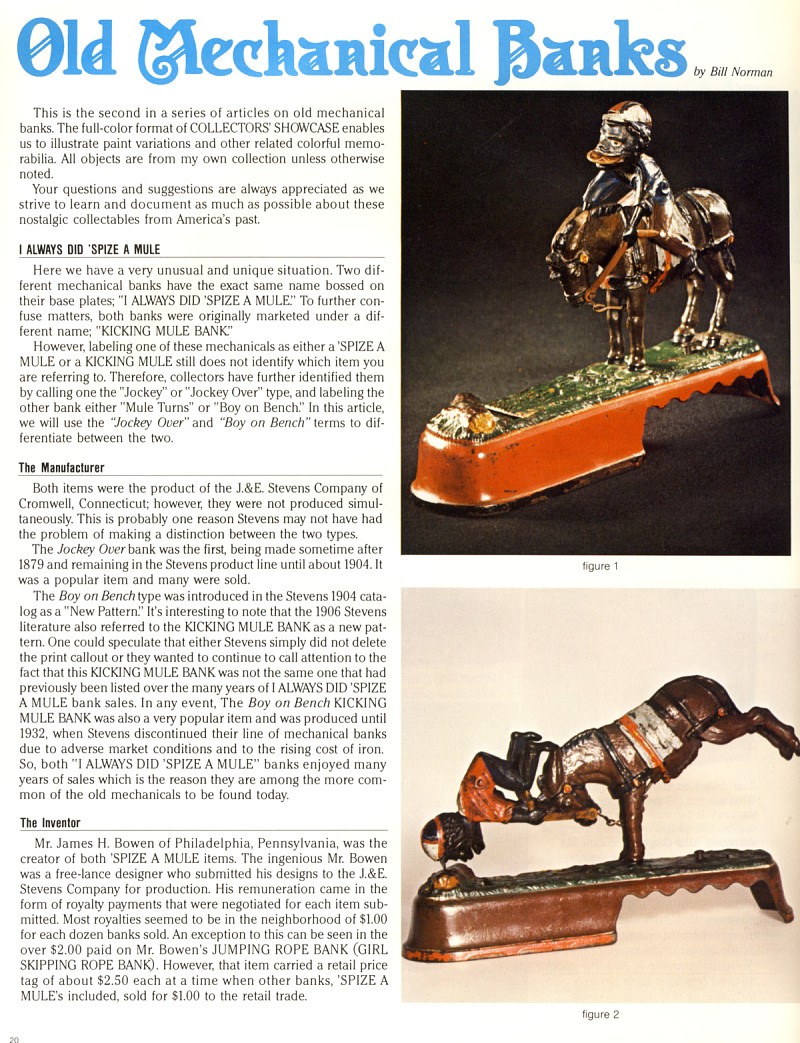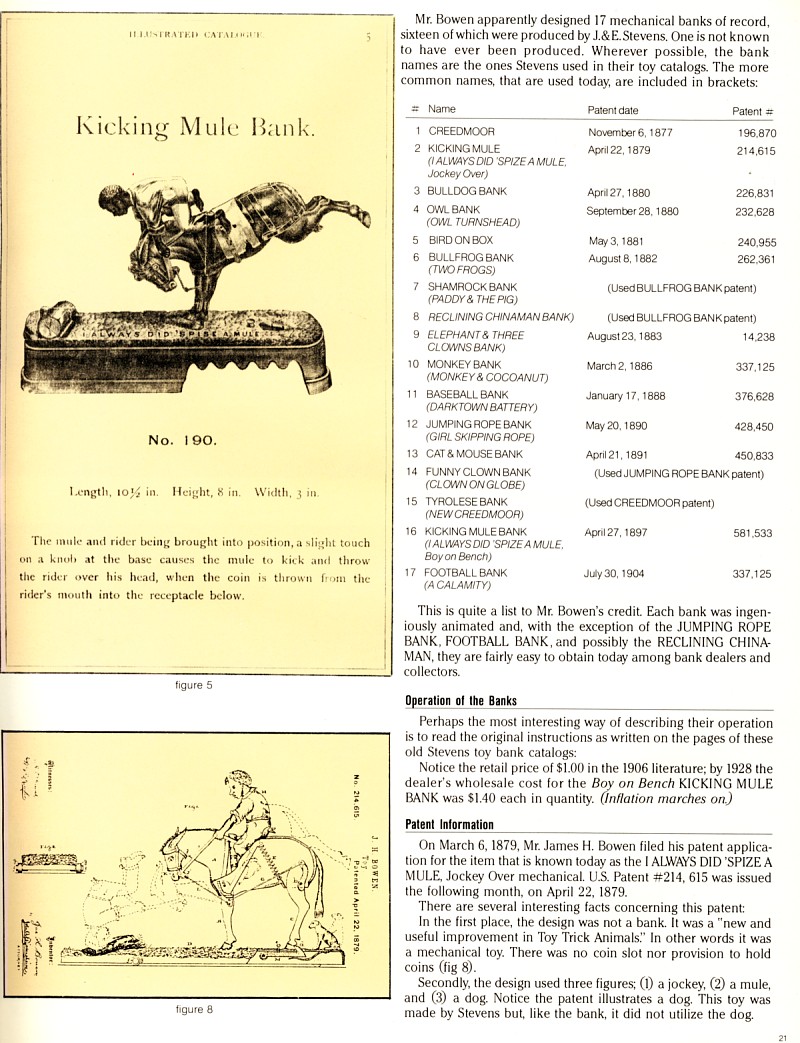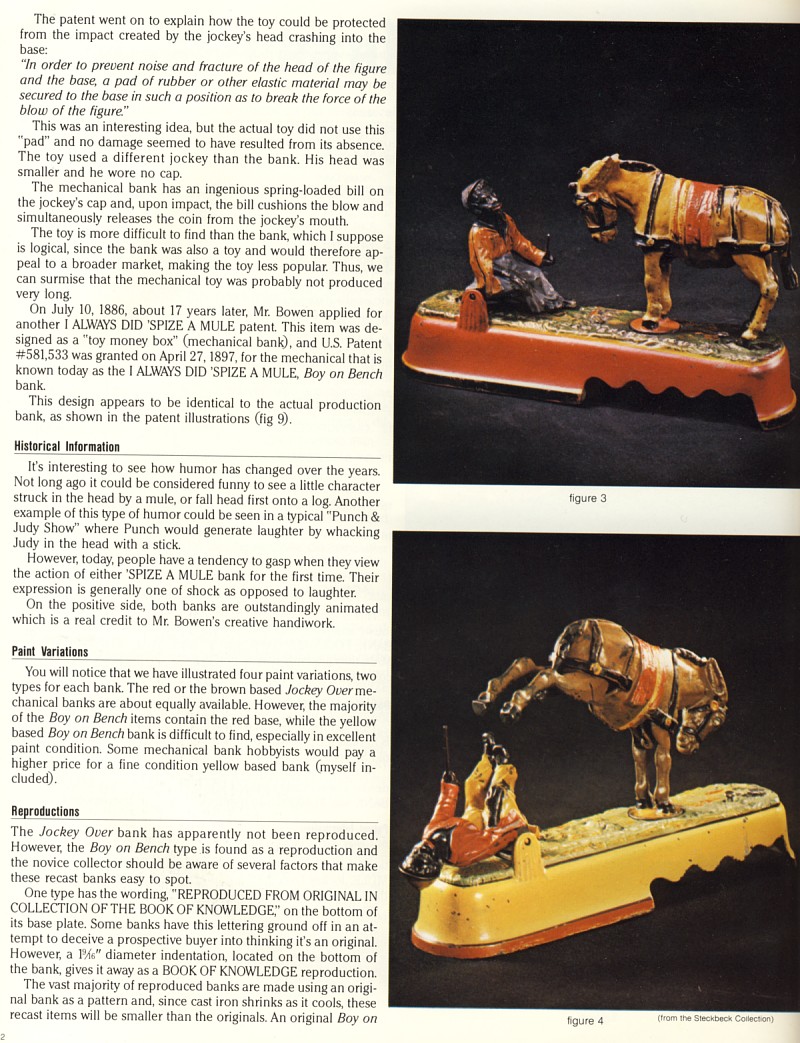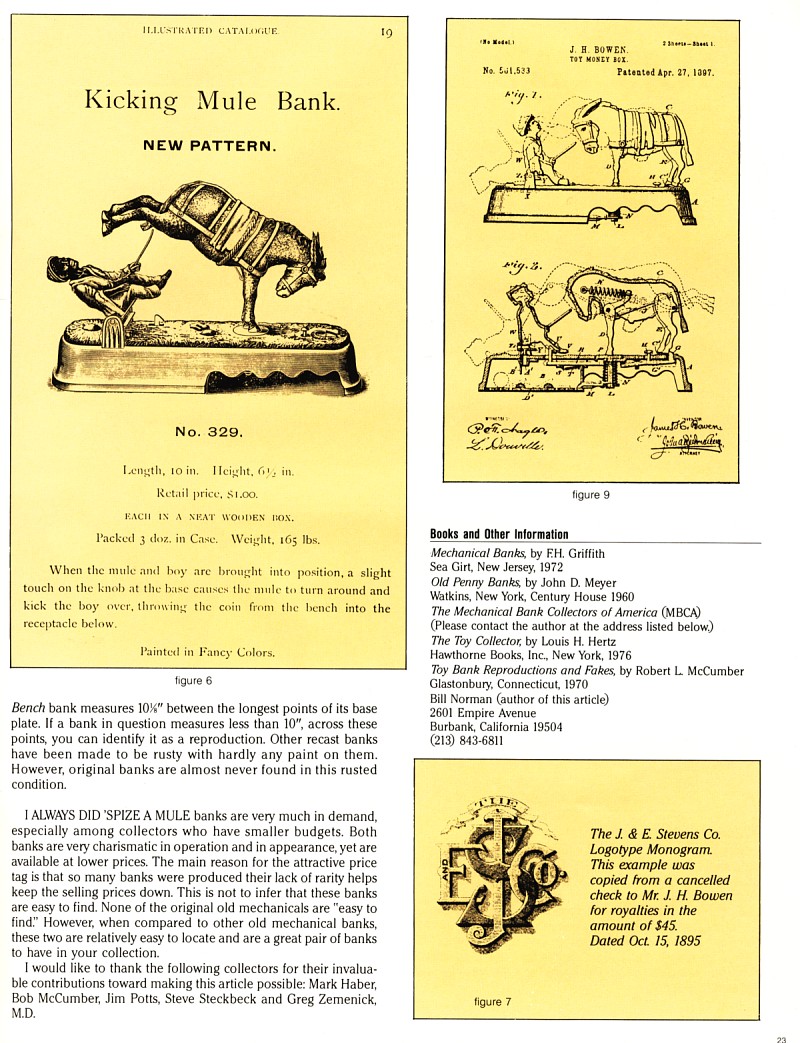|
Collectors' SHOWCASE,
July/August 1982,
Volume 1, Number 6 — Pages 20 through 23
Old Mechanical Banks
by Bill Norman
This is the second in a series of articles on old mechanical banks.
The full-color format of COLLECTORS' SHOWCASE enables us to illustrate
paint variations and other related colorful memorabilia. All objects are
from my own collection unless otherwise noted.
Your questions and suggestions are always appreciated as we strive
to learn and document as much as possible about these nostalgic
collectables from America's past.
I ALWAYS DID 'SPIZE
A MULE
Here we have a very unusual and unique situation. Two different
mechanical banks have the exact same name bossed on their base plates;
"I ALWAYS DID 'SPIZE A MULE' To further confuse matters, both banks were
originally marketed under a different name; "KICKING MULE BANK."
However, labeling one of these mechanicals as either a 'SPIZE A
MULE or a KICKING MULE still does not identify which item you are
referring to. Therefore, collectors have further identified them by
calling one the "Jockey" or "Jockey Over" type, and labeling the other
bank either "Mule Turns" or "Boy on Bench." In this article, we will use
the
"Jockey Over" and
"Boy on Bench" terms to differentiate between the two.
The Manufacturer
Both items were the product of the J.&E. Stevens Company of
Cromwell, Connecticut; however, they were not produced simultaneously.
This is probably one reason Stevens may not have had the problem of
making a distinction between the two types.
The
Jockey Over bank was the first, being made sometime after
1879 and remaining in the Stevens product line until about 1904. It was
a popular item and many were sold.
The
Boy
on Bench type was introduced in the Stevens 1904 catalog as
a "New Pattern." It's interesting to note that the 1906 Stevens
literature also referred to the KICKING MULE BANK as a new pattern. One
could speculate that either Stevens simply did not delete the print
callout or they wanted to continue to call attention to the fact that
this KICKING MULE BANK was not the same one that had previously been
listed over the many years of I ALWAYS DID 'SPIZE A MULE bank sales. In
any event, The Boy on Bench KICKING MULE BANK was also a very popular
item and was produced until 1932, when Stevens discontinued their line
of mechanical banks due to adverse market conditions and to the rising
cost of iron. So, both "I ALWAYS DID 'SPIZE A MULE" banks enjoyed many
years of sales which is the reason they are among the more common of the
old mechanicals to be found today.
The Inventor
Mr. James H. Bowen of Philadelphia, Pennsylvania, was the creator
of both 'SPIZE A MULE items. The ingenious Mr. Bowen was a free-lance
designer who submitted his designs to the .I.& E. Stevens Company for
production. His remuneration came in the form of royalty payments that
were negotiated for each item submitted. Most royalties seemed to be in
the neighborhood of $1.00 for each dozen banks sold. An exception to
this can be seen in the over $2.00 paid on Mr. Bowen's JUMPING ROPE BANK
(GIRL. SKIPPING ROPE BANK). However, that item carried a retail price
tag of about $2.50 each at a time when other banks, 'SPIZE A MULE's
included, sold for $1.00 to the retail trade.
Mr. Bowen apparently designed 17 mechanical banks of record,
sixteen of which were produced by J.&E.Stevens. One is not known to have
ever been produced. Wherever possible, the bank names are the ones
Stevens used in their toy catalogs. The more common names, that are used
today. are included in brackets:
# Name
1 CREEDMOOR
2 KICKING MULE
(I ALWAYS DID 'SPIZE
A MULE, Jockey
Over)
3 BULLDOG BANK
4 OWL BANK
(OWL TURNS HEAD)
5 BIRD ON BOX
6 BULLFROG BANK
(TWO FROGS)
7 SHAMROCK BANK
(Used BULLFROG BANK
patent, PADDY & THE
PIG)
8 RECLINING CHINAMAN BANK)
(Used BULLFROG BANK
patent)
9 ELEPHANT& THREE
CLOWNS BANK)
10 MONKEY BANK
(MONKEY & COCOANUT)
11 BASEBALL BANK
(DARKTOWN BATTERY)
12 JUMPING ROPE BANK
(GIRL SKIPPING ROPE)
13 CAT & MOUSE BANK
14 FUNNY CLOWN BANK
(Used
JUMPING ROPE BANK
patent,
CLOWN ON GLOBE)
15 TYROLESE BANK
(Used
CREEDMOOR
patent, NEW CREEDMOOR)
16 KICKING MULE BANK
(ALWAYS DID SPIZE A MULE,
Boy on
Bench)
17 FOOTBALL BANK
(A CALAMITY) |
Patent date
November 6, 1877
April 22, 1879
April 27, 1880
September 28, 1880
May 3, 1881
August 8, 1882
(Used BULLFROG BANK
patent)
(Used BULLFROG BANK patent)
August 23, 1883
March 2, 1886
January 17, 1888
May 20, 1890
April 21. 1891
(Used JUMPING ROPE BANK patent)
(Used CREEDMOOR patent)
April 27, 1897
July 30, 1904
|
Patent
#
196,870
214,615
226,831
232,628
240,955
262,361
14,238
337,125
376,628
428,450
450,833
581,533
337,125
|
Operation al the Banks
Perhaps the most interesting way of describing their operation is
to read the original instructions as written on the pages of these old
Stevens toy bank catalogs:
Notice the retail price of $1.00 in the 1906 literature; by 1928
the dealer's wholesale cost for the Boy on Bench KICKING MULE BANK was
$1.40 each in quantity. (Inflation marches on)
Patent Information
On March 6. 1879, Mr. James H. Bowen filed his patent application
for the item that is known today as the I ALWAYS DID 'SPIZE A MULE,
Jockey Over mechanical U.S. Patent #214,615 was issued the following
month, on April 22, 1879.
There are several interesting facts concerning this patent:
In the first place, the design was not a bank. It was a "new and
useful improvement in Toy Trick Animals." In other words it was a
mechanical toy. There was no coin slot nor provision to hold coins (fig
8).
Secondly, the design used three figures; (1) a jockey, (2) a mule,
and (3) a dog. Notice the patent illustrates a dog. This toy was made by
Stevens but, like the bank, it did not utilize the dog.
The patent went on to explain how the toy could be protected from
the impact created by the jockey's head crashing into the base:
"In
order to prevent noise and fracture of the head of the figure and the
base, a pad of rubber or other elastic material may be secured to the
base in such a position as to break the force of the blow of the
figure."
This was an interesting idea, but the actual toy did not use
this "pad" and no damage seemed to have resulted from its absence. The
toy used a different jockey than the bank. His head was smaller and he
wore no cap.
The mechanical bank has an ingenious spring-loaded bill on the
jockey's cap and, upon impact, the bill cushions the blow and
simultaneously releases the coin from the jockey's mouth.
The toy is more difficult to find than the bank, which I suppose is
logical, since the bank was also a toy and would therefore appeal to a
broader market, making the toy less popular. Thus, we can surmise that
the mechanical toy was probably not produced very long.
On July 10, 1886, about 17 years later, Mr. Bowen applied for
another I ALWAYS DID 'SPIZE A MULE patent. This item was designed as a
"toy money box" (mechanical bank), and U.S. Patent #581,533 was granted
on April 27,1897, for the mechanical that is known today as the I ALWAYS
DID 'SPIZE A MULE, bank.
This design appears to be identical to the actual production bank,
as shown in the patent illustrations (fig 9).
Historical
information
It's interesting to see how humor has changed over the years. Not
long ago it could be considered funny to see a little character struck
in the head by a mule, or fall head first onto a log. Another example of
this type of humor could be seen in a typical "Punch & Judy Show" where
Punch would generate laughter by whacking Judy in the head with a stick.
However, today, people have a tendency to gasp when they view the
action of either 'SPIZE A MULE bank for the first time. Their expression
is generally one of shock as opposed to laughter.
On the positive side, both banks are outstandingly animated which
is a real credit to Mr. Bowen's creative handiwork.
Paint Variations
You will notice that we have illustrated four paint variations, two
types for each bank. The red or the brown based
Jockey Over mechanical banks are about equally available.
However, the majority of the
Boy
on Bench items contain the red base, while the yellow based
Boy
on Bench bank is difficult to find, especially in excellent
paint condition. Some mechanical bank hobbyists would pay a higher price
for a fine condition yellow based bank (myself included).
Reproductions
The
Jockey Over bank has apparently not been reproduced.
However, the
Boy
on Bench type is found as a reproduction and the novice
collector should be aware of several factors that make these recast
banks easy to spot.
One type has the wording, "REPRODUCED FROM ORIGINAL IN COLLECTION
OF THE BOOK OF KNOWLEDGE," on the bottom of its base plate. Some banks
have this lettering ground off in an attempt to deceive a prospective
buyer into thinking it's an original. However, a 1-9/16" diameter
indentation, located on the bottom of the bank, gives it away as a BOOK
OF KNOWLEDGE reproduction.
The vast majority of reproduced banks are made using an original
bank as a pattern and, since cast iron shrinks as it cools, these recast
items will be smaller than the originals. An original
Boy
on Bench bank measures 10-1/8" between the longest points of
its base plate. If a bank in question measures less than 10", across
these points, you can identify it as a reproduction. Other recast banks
have been made to be rusty with hardly any paint on them. However,
original banks are almost never found in this rusted condition.
I ALWAYS DID 'SPIZE A MULE banks are very much in demand,
especially among collectors who have smaller budgets. Both banks are
very charismatic in operation and in appearance, yet are available at
lower prices. The main reason for the attractive price tag is that so
many banks were produced their lack of rarity helps keep the selling
prices down. This is not to infer that these banks are easy to find.
None of the original old mechanicals are "easy to find." However, when
compared to other old mechanical banks, these two are relatively easy to
locate and are a great pair of banks to have in your collection.
I would like to thank the following collectors for their invaluable
contributions toward making this article possible: Mark Haber, Bob
McCumber, Jim Potts, Steve Steckbeck and Greg Zemenick, M.D.
Books and Other Information
Mechanical Banks by F.H. Griffith Sea Girt, New Jersey, 1972
Old
Penny Banks, by John D. Meyer Watkins, New York, Century
House 1960
The Mechanical Bank Collectors of America (MBCA)
(Please contact the author at the address listed below)
The
Toy Collector, by Louis H. Hertz, Hawthorne Books, Inc., New
York, 1976
Toy
Bank Reproductions and Fakes, by Robert L. McCumber
Glastonbury, Connecticut, 1970
Bill Norman (author of this article) 2601 Empire Avenue, Burbank.
California 19504, (213) 843-6811
|





